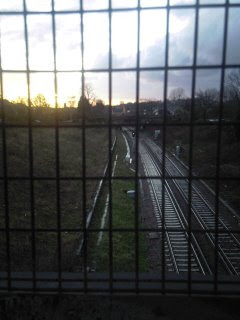 Gellatly
Gellatly Road is another SE14 border road – SE15 starts at the bottom of the gardens of the houses on the western side. It is also the edge of the
Telegraph Hill conservation area, made up of the housing built by the Haberdashers Company in late Victorian times. Most of the houses have details like the head and foliage decorations (the pictured example is from no.58). The Doctor’s surgery at 42
Gellatly Road also has a rare surviving example of the ornate tiles that once lined the doorsteps of all these houses.

The Haberdashers company do not seem to have been too good at providing for the social needs of residents beyond housing – the only pub and the only shop in the conservation area (excepting those on New Cross Road) are situated on
Gellatly Road. The latter is the superior
cornershop ‘
Gellatly Supermarket’ the former is
Skehans pub (formerly
Mcconnells and before that the Duke of Connaught), South London’s premier Irish-Thai establishment. The
décor inside the pub includes a mixture of Irish and Thai
bric-a-
brac, such as musical instruments, and behind the pub in a converted stable block is a proper Thai restaurant,
Chai’s Garden. The food is generally excellent. Back in the pub there’s a quiz night on Tuesdays and usually music at the weekends.
One of the
notable features of the road is how busy it is, forming as it does part of the B2142. Compare the completely different feel in the parallel
Bousfield Road, identical in many respects but without the traffic. It is one of the idiosyncrasies of traffic control in the area that most vehicles are channelled up this relatively narrow road, while the wide boulevards of
Jerningham and Pepys Road are kept relatively quiet. The sweeping corner from
Lausanne Road into
Gellatly Road has always struck me as particularly dangerous, enabling cars to zoom round without being able to see people crossing to the shop.
Still at least the traffic is tempered a bit by the speed humps, the result of a successful campaign in the early 1990s by local residents who staged actions including crossing the road continuously during the rush hour and hiring skips to slow down the traffic. Funnily enough the story of the Battle of
Gellatly Road is told in a school textbook,
Geography in Action (1995), as an example of neighbourhood campaign to improve city life.
The name of the road changes to
Drakefell Road as it passes the junction with
Kitto Road and heads over the hill and down towards
Brockley Cross. As well as the Victorian terraces and 20
th century council blocks (Fern Court) there is an interesting 2-storey wooden structure,
Greenstreet Hill, a self-build housing project developed by a housing co-op in the 1990s. It backs on to Telegraph Hill Park and brings some of the feel of the park on to the road with hazel bushes covering the front, from behind which a
model of Anubis watches the traffic (not a rabbit statue as I once thought).
Next to
Greenstreet, and entirely hidden by a large hedge, is another interesting building – one of the last prefab bungalows in the area. These white ‘temporary’ buildings were put up on bomb sites after World War Two with an expected life of ten years, but many survived 50 years or more. A row of them on
Kitto Road were only demolished in the 1990s to make way for the new housing opposite the park.
As we move down
Drakefell Road we cross from SE14 to SE4 – are we still in New Cross? For the purposes of my Walking New Cross project I am assuming that New Cross=SE14, but I know it’s not that simple. Some people who live in
Gellatly or
Drakefell might describe themselves as living in New Cross, others Telegraph Hill, some
Nunhead or
Brockley depending on their precise location. And it’s always been this way – a search through the adverts in The Times newspaper shows how these roads, and indeed the wider area, have always moved around on people’s mental map of South London:
- an advert in 1889 gave an address at ‘94
Drakefell Road, St Catherine’s Park,
Peckham’ (Times 15.8.1889);
- Arthur Jackson, a Professor of Music, was mentioned as living in ‘
Drakefell Road,
Nunhead’ (Times 22.6.1892);
- the birth of a son to James Garrett took place at ‘122
Drakefell Road,
Hatcham’ (Times 5.6.1897);
- the death of Caroline Clark took place at ‘
Drakefell Road,
Brockley’ (21.6.1906) ;
- a fundraising concert for a hospital ambulance took place ‘per Mrs
Huggett and Mrs Everett’ at ‘
Drakefell Road, New Cross’ (Times 27.11.1914).
Brockley,
Peckham,
Hatcham, New Cross,
Nunhead or even the now-forgotten St. Catherine’s Park – take your pick.
 A couple of interesting-sounding nights coming up in Deptford.
A couple of interesting-sounding nights coming up in Deptford.



















.jpg)












